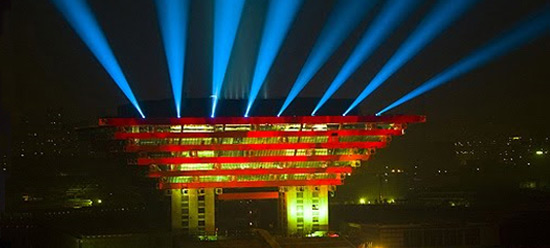Shanghai Expo 2010: The Chinese Pavilion

The 2010 World Exposition in Shanghai will be the first registered one in a developing country. Officially known as “Expo Shanghai 2010,” it will last 184 days and provide China an opportunity to show off its remarkable economic growth. The expo will also give foreign nations and companies a chance to further develop business partnerships with China and Chinese companies. This is the sixteenth in an ongoing series that will look at the upcoming expo, from country pavilions to trade development. In this article, we take a look at the Chinese Pavilion.
By Joe Drury
May 1 – On May 1, 1851 London opened the doors of the sparkling Crystal Palace for the first World Expo, a celebration of predominantly Western cultural and technological achievements in the midst of one of the greatest turning points of human history, the Industrial Revolution.
At the other end of the world, China was reeling from economic hardship, a series of natural calamities, and humiliating military losses to western powers. The Taiping Rebellion, a violent response to these difficulties and a challenge to the ever-weakening corrupt Manchu government, snowballed into a civil war that would claim 20 million lives and help precipitate an end to thousands of years of dynastic rule in China.
A century and a half after this remarkable contrast of circumstances, Shanghai will open the doors to a country radically different than the China of 1851. In an Expo area twice the size of Monaco with an estimated overall cost of US$58 billion, the World Expo 2010 will showcase the Chinese government’s role in radically improving China’s socioeconomic conditions and its success in kick-starting and revving the world’s fastest growing economy.
Central to the historical significance of this bustling activity looms the Chinese national pavilion, named “The Crown of the East”. The 1.5 billion yuan (US$220 million) building radiates a Forbidden City-red and towers at 63 meters, triple the height of any other pavilion. Its “crown” moniker comes from a unique overhanging roof, constructed using dougong.
Utilized in traditional Chinese construction for nearly 3,000 years, dougong are interlocking wooden brackets that can hold a roof without fasteners through meticulous joinery. Although they were used most prominently in China’s Spring and Autumn Period (770 to 476 B.C.), their popularity spread past borders to influence other Asian countries’ architecture, including Korea and Japan.
“The construction scheme for the China Pavilion contains rich elements of Chinese culture and could well display Chinese wisdom,” Shanghai Vice-Mayor Yang Xiong said during a ceremony revealing the pavilion’s design. “It also has international features, modernity and could serve as a symbol. It helps develop the theme of the 2010 Expo.”
Expo organizers selected the final design from a pool of 344 submissions. He Jingtang, director of the Architectural Academy of the South China University of Technology ultimately came up with the winning design. In addition to their significance as an object of Chinese antiquity, the roof’s 56 dougong symbolically represent the 56 ethnic minorities of China.
With the theme “Chinese wisdom in urban development,” the pavilion also aims to promote China’s values of harmony, nature and spirit. Keeping in sync with many other pavilions’ decision to incorporate sustainable technologies and energy-saving measures into their design, the pavilion employs energy saving technologies, such as rainwater harvesting and natural ventilation systems.
The theme is also integrated into a 15,800 square-meter exhibition space inside the pavilion, starting at the upper core area where visitors will enjoy a multimedia film about the evolution of China’s cities. After the eight-minute film one then moves into a room covered with an enlarged replica of Zhang Zeduan’s famous painting, “Along the River During Qingming Festival”. The lively characters of this street scene will appear moving to visitors, and the festive scene represents the need for urban planning to encourage social and cultural gathering.
Visitors are then led to a sightseeing cable car, which passes over a replica of an ancient city to feature Chinese innovations in practical architecture and artistic design. The final section of the journey is focused on China’s low carbon future, and demonstrates China’s efforts to deal with climate change amidst massive urbanization and development.
“We hope to emphasize the harmonious relationships between humans and nature and adhere to sustainable development for the cities of the future,” said Qian Zhiguang, Minister in Charge of the Chinese Pavilion for the Shanghai World Expo Coordination Bureau in an interview with CCTV. “A low carbon future goes along with Chinese wisdom and the modern pursuit of imitating nature, which means doing so in the proper ways, using it with moderation and returning it to the original state.”
The pavilion’s offerings continue outside the central structure, where a 45,000 square-meter joint pavilion showcases exhibitions from China’s provinces, municipalities, and autonomous regions. In addition to furthering the Expo’s theme of innovative urbanization, these pavilions will express the diverse nature of China’s regional cultures and customs.
From this experience, the tens of thousands of guests visiting the pavilion every day will likely impart with two impressions. One is of a country with a rich yet difficult past eager to showcase its rapid economic and political ascent. The second is of a country still facing remarkable challenges that must be solved with original solutions. With 350 million people moving from the countryside to the city by 2025, these solutions cannot come sooner.
Further Reading
The complete Shanghai Expo 2010 series
- Previous Article New Issue of China Briefing Magazine: Opportunities in China’s Emerging Industries
- Next Article Notice on Corporate Income Tax for Cross-Regional Construction Enterprises









